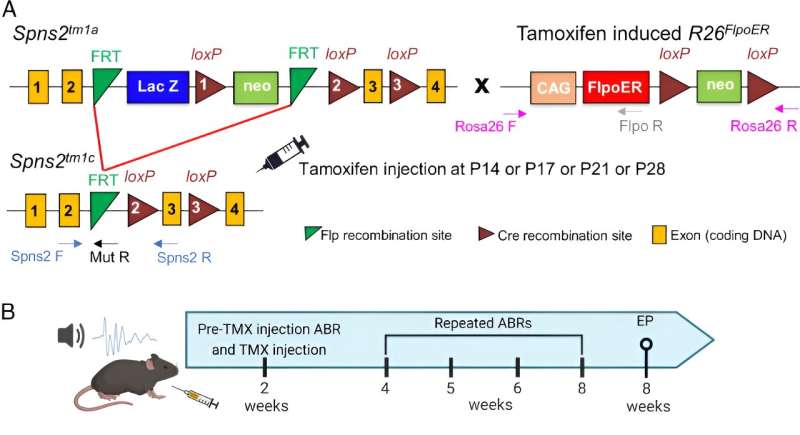This article has been reviewed according to Science X's editorial process and policies. Editors have highlighted the following attributes while ensuring the content's credibility:
fact-checked
peer-reviewed publication
trusted source
proofread
Researchers reverse hearing loss in mice

New research from The Institute of Psychiatry, Psychology & Neuroscience (IoPPN) at King's College London has successfully reversed hearing loss in mice.
The research, titled "Reversal of an existing hearing loss by gene activation in Spns2 mutant mice" and published in Proceedings of the National Academy of Sciences, used a genetic approach to fix deafness in mice with a defective Spns2 gene, restoring their hearing abilities in low and middle frequency ranges. Researchers say this proof-of-concept study suggests that hearing impairment resulting from reduced gene activity may be reversible.
Moer than half of adults in their 70s experience significant hearing loss. Impaired hearing is associated with an increased likelihood of experiencing depression and cognitive decline, as well as being a major predictor of dementia. While hearing aids and cochlear implants may be useful, they do not restore normal hearing function, and neither do they halt disease progression in the ear. There is a significant unmet need for medical approaches that slow down or reverse hearing loss.
Researchers in this study bred mice with an inactive Spns2 gene. Mice were then provided with a special enzyme at differing ages to activate the gene after which their hearing improved. This was found to be most effective when Spns2 was activated at a young age, with the positive effects of gene activation becoming less potent the longer the researchers waited to provide the intervention.
"Degenerative diseases such as progressive hearing loss are often believed to be irreversible, but we have shown that at least one type of inner ear dysfunction can be reversed. We used a genetic method to show this reversal as a proof-of-concept in mice, but the positive results should encourage research into methods like gene therapy or drugs to reactivate hearing in people with a similar type of hearing loss, "says Professor Karen Steel, professor of sensory function at King's IoPPN and the study's senior author.
Dr. Elisa Martelletti, the study's first author from King's IoPPN said, "Seeing the once-deaf mice respond to sounds after treatment was truly thrilling. It was a pivotal moment, demonstrating the tangible potential to reverse hearing loss caused by defective genes. This groundbreaking proof-of-concept study unlocks new possibilities for future research, sparking hope for the development of treatments for hearing loss."
More information: Elisa Martelletti et al, Reversal of an existing hearing loss by gene activation in Spns2 mutant mice, Proceedings of the National Academy of Sciences (2023). DOI: 10.1073/pnas.2307355120



















